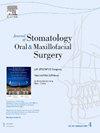使用髂骨瓣和腓骨瓣重建下颌骨的形态和功能分析回顾性研究
IF 2
3区 医学
Q2 DENTISTRY, ORAL SURGERY & MEDICINE
Journal of Stomatology Oral and Maxillofacial Surgery
Pub Date : 2025-03-26
DOI:10.1016/j.jormas.2025.102322
引用次数: 0
摘要
目的:本回顾性研究旨在评估和比较使用髂骨和腓骨皮瓣进行下颌骨重建的形态学和功能特征,以确定其各自的有效性,并确定提供最佳患者结果的技术。方法:对121例患者(84例髂骨瓣,37例腓骨瓣)术前、术后的影像学资料进行分析。使用Mimics软件通过比较形态学参数(距离和角度)以及受影响侧和未受影响侧之间的对称性来评估下颌重建。使用改良版的华盛顿大学生活质量问卷(UW-QOL)第4版对患者的生活质量进行评估,该问卷评估头颈癌治疗的功能和社会心理结果。结果:结果显示髂组在D2和D3距离以及未受影响侧CA角方面表现出显著优于髂组。相比之下,腓骨组在这些参数上没有明显的优势。关于对称性,髂骨组在距离D3上获得更好的结果,而腓骨组在角度测量上表现出色。此外,髂骨组保持更好的b角稳定性。在骨尺寸方面,髂骨瓣能更好地保留牙槽底高度(ABH)和宽度(ABW),比腓骨瓣提供更一致和良好的结果。在生活质量方面,两组之间没有观察到总体差异(使用UW-QOL问卷评估)。然而,具体的差异被注意到:腓骨组在疼痛、活动和娱乐方面得分更高,而髂骨组在外观和语言方面得分更高。结论:与腓骨瓣相比,髂骨瓣具有更好的形态稳定性、更好的骨尺寸保存和更坚固的结构一致性,是下颌骨重建的首选。虽然这两种技术的总体生活质量相当,但髂皮瓣表现出更明显的临床效益,导致最佳的术后结果。本文章由计算机程序翻译,如有差异,请以英文原文为准。
Retrospective study of morphological and functional analysis of mandibular reconstructions using iliac and fibular flaps
Objective
This retrospective study aims to evaluate and compare the morphological and functional characteristics of mandibular reconstructions performed using iliac and fibular flaps to determine their respective effectiveness and identify the technique that offers the best patient outcomes.
Methods
Medical and imaging data were analysed from pre- and post-operative scans of 121 patients (84 with iliac flaps and 37 with fibular flaps). Mandibular reconstructions were assessed by comparing morphometric parameters (distances and angles) and symmetry between the affected and unaffected sides using Mimics software. The quality of life of patients was assessed using a modified version of the University of Washington Quality of Life Questionnaire (UW-QOL), version 4, which evaluates functional and psychosocial outcomes in head and neck cancer treatment
Results
The results show that the iliac group demonstrates significantly superior performance for distances D2 and D3 and for the CA angle on the unaffected side. In contrast, the fibular group shows no significant advantage in these parameters. Regarding symmetry, the iliac group achieves better results for distance D3, whereas the fibular group excels in angular measurements. Additionally, the iliac group maintains better stability for angle B. Regarding bone dimensions, the iliac flap better preserves alveolar base height (ABH) and width (ABW), providing more consistent and favorable outcomes than the fibular flap.No overall difference was observed between the two groups regarding quality of life (assessed using the UW-QOL questionnaire). However, specific variations were noted: the fibular group scores higher for pain, activity, and recreation, while the iliac group achieves better results in appearance and speech.
Conclusion
The iliac flaps are the preferred option for mandibular reconstruction, offering superior morphometric stability, better preservation of bone dimensions, and more robust structural consistency than fibular flaps. Although both techniques yield comparable overall quality-of-life results, iliac flaps demonstrate more pronounced clinical benefits, leading to optimal postoperative outcomes.
求助全文
通过发布文献求助,成功后即可免费获取论文全文。
去求助
来源期刊

Journal of Stomatology Oral and Maxillofacial Surgery
Surgery, Dentistry, Oral Surgery and Medicine, Otorhinolaryngology and Facial Plastic Surgery
CiteScore
2.30
自引率
9.10%
发文量
0
审稿时长
23 days
 求助内容:
求助内容: 应助结果提醒方式:
应助结果提醒方式:


